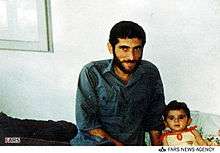Hamid Bakeri
| Hamid Bakeri | |
|---|---|
 | |
| Deputy of the 31 Ashura Division of Islamic Revolutionary Guard Corps | |
| Personal details | |
| Born |
December 1955 Miandoab, Iran |
| Died |
February 25, 1984 Majnoon Island, Iraq |
| Resting place | his corpse has not been found |
| Nationality | Iranian |
| Relations |
Ali Bakeri Mehdi Bakeri |
| . | |
| Military service | |
| Allegiance |
|
| Service/branch |
|
| Rank | Major-General (posthumously) |
| Commands |
Najaf Ashraf Brigade (commander) Hazrat-e-Abolfazl Brigade (commander) 31st Ashura Division (deputy) |
| Battles/wars |
|
General Hamid Bakeri (1955–1984) was born in West Azerbaijan Province. Before the Islamic Revolution, he was a member of opposition groups against the Shah's regime. He became an Islamic Revolutionary Guard Corps commander in Iran–Iraq War. He was killed in Operation Kheibar, and his body has not been found.
Early life
Hamid Bakeri was born to a religious family in Miandoab, West Azerbaijan Province. His mother died in a car accident when he was a small child. Hamid was close to his brother, Mehdi Bakeri. They started their opposition work against the Shah's regime while studying in high school. They were taught Islam, politics and revolution by their older brother, Ali Bakeri, an Assistant Professor of Sharif University of Technology, who was killed by SAVAK in 1972. After high school, Hamid decided to study abroad. At first he traveled to Turkey and then to Aachen, Germany. While in Germany he frequented the Islamic Centre Hamburg.[1][2]
Islamic Revolution
When Ruhollah Khomeini fled to France in 1978, Hamid left his studies and went to Paris. He had a new mission in Paris: He was dispatched to Syria and Lebanon to learn how to conduct guerrilla warfare. Additionally, Hamid and his brother, Mehdi Bakeri, started to smuggle weapons inside Iran to arm opposition groups.
In 1979, when Khomeini returned to Iran on the heels of the Iranian Revolution, Hamid followed. Hamid, Mehdi and revolutionary forces took the control of the cities and military centers, and began training new revolutionary forces. He enlisted in the Islamic Revolutionary Guard Corps in the city of Urmia.
When conflicts intensified in Kurdistan, Bakeri and his companions Were dispatched to the region to regain regime control. He also played an important role in regaining Mahabad, Piranshahr and Baneh. They undertook reconstruction efforts in these cities after the campaigns concluded.[1][2][3]
Iran–Iraq War
In September 1980, Iraq attacked Iran. Bakeri was sent to break the Siege of Abadan. After a short stint working at his town hall back home, he returned to battlefields. First he participated in Operation Fath ol-Mobin. In Operation Beit ol-Moqaddas, he was the battalion commander of Najaf Ashraf brigade and contributed to efforts to breaking the Abadan siege. He also participated in Operation Muslim ibn Aqeel in Sumar, Iran, resulting in an injury to his hand. He was appointed as the commander of Hazarate-Abolfazl brigade and then the deputy commander of 31st Ashura Division. In Operation Moharam and Operation Dawn 2, his foot was injured and he was transmitted to Tehran for medical treatment.[1][2][3]
Operations
Death
In Operation Kheibar, Bakeri and his companions attempted capture the Majnon bridge so they could encircle the enemy, an important part of the operation. After two days of fighting, he was killed. Bakeri's body was never located.[1][2]
See also
References
- 1 2 3 4 5 "شخصیت نگار". shakhsiatnegar.com.
- 1 2 3 4 5 "خبرگزاری ایمنا". imna.ir. Archived from the original on 2015-02-12.
- 1 2 "زندگی نامه شهید حمید باکری". www.khomool.ir.
- ↑ "شهید "حمید باکری" مرد جاودانه عملیات خیبر". tebna.i.